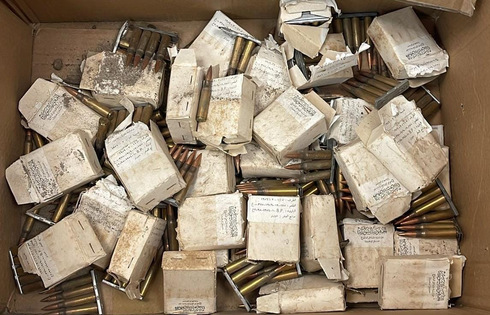Copyright ynetnews

Along the volatile Israel-Syria border, where law and order have long collapsed, criminals and terror operatives have discovered a lucrative new path — smuggling weapons through the Golan Heights to meet Israel’s growing black-market demand. Earlier this month, a soldier from the IDF’s 595th Battalion spotted a cyclist riding suspiciously along the Israeli side of the border fence. Moments later, she noticed movement on the Syrian side. Within seconds, troops from the 7241st Battalion were dispatched, blocking nearby roads. Surveillance cameras tracked the cyclist as he picked up a bag tossed from Syria, then loaded his bike onto a waiting car. The suspects — one an Eritrean national residing illegally in Israel, the other a new immigrant from Ethiopia — were later arrested near Hushniya Junction. Inside their vehicle, police found cash, drugs, and five pistols. Prosecutors have since filed indictments. But behind this isolated bust lies a new and dangerous smuggling network, stretching from Syrian villages near the frontier deep into Israeli territory. “It’s crucial to stop these operations while they’re still criminal,” said Lt. Col. B., commander of the 7241st Battalion. “If we don’t, they could easily evolve into terror infiltrations.” From drug mules to organized arms runners In the chaotic borderlands of southern Syria, there is no functioning government, police, or enforcement. The vacuum has allowed smugglers, militias, and terror groups to collaborate for profit. “You have civilians trying to live their lives alongside armed factions who hate us,” Lt. Col. B. said. Israel’s northern smuggling patterns have long been shaped by geopolitical and security shifts in the region. The collapse of Bashar Assad’s control in southern Syria, instability in Lebanon, and a porous Jordanian border have opened new routes for traffickers. “On the morning of October 7, 2023, I was lying in ambush on the Lebanese border,” recalled Chief Superintendent Oshri Amor, head of the Israel Police’s Border Crimes Unit. “When the Hamas attack began, we prepared to move south, but were ordered to stay — there was real concern that Hezbollah would open the northern front.” Today, Amor oversees the fight against organized crime and arms smuggling across Israel’s northern borders. “When one route is closed, they immediately find another — like mushrooms after the rain,” he said. “Now they’ve found one in Syria.” The Syrian frontier: a fragile balance Unlike Lebanon, where movement near the fence is strictly forbidden, Syrian villages sit just meters from the border, making it far easier to toss weapons across and disappear into civilian areas. “In one incident,” said Lt. Col. B., “someone simply threw a bundle of handguns wrapped in socks over the fence, jumped into a car, and vanished. It’s nearly impossible to tell who’s a terrorist, who’s a smuggler, and who’s just a farmer.” Lt. Col. G., commander of the 595th Battalion, said the lessons of October 7 have reshaped IDF tactics: “We’ve learned that we need eyes in the back of our head. Every new sector we enter, we study its patterns — what’s routine, and what breaks that routine.” Another recent case occurred during riots in the Golan, when several Druze men crossed into Syria and returned with a Kalashnikov and ammunition. A separate police operation uncovered a cache of smuggled ammo buried near Majdal Shams — dozens of 7.62 mm rounds intended for Israeli crime networks. The business of smuggling: 'The profit is irresistible' For criminals, Israel’s demand for illegal firearms makes the risk worth it. “If an M-16 sells for $1,000 in Jordan, here it can fetch up to $10,000,” said Chief Superintendent Amor. “The profit is irresistible. One successful run of 20 weapons can mean a fortune.” While the Syrian and Lebanese borders are under tighter military control, the Jordanian frontier — stretching 500 kilometers — remains Israel’s most vulnerable, with dozens of smuggling attempts every day, often carried out using advanced drones. According to police data, over the past three months alone, more than 1,400 smuggling incidents were detected along the Jordanian border. Each operation typically involves around 20 firearms — mostly pistols and M-16 rifles. On October 22, near Kibbutz Hamadia, police spotted two cars hiding in a field with a drone loaded with cannabis meant to cross into Jordan. Four suspects from southern Israel were arrested. “The drones make it easier — no fence, no throwing bags, no hiding,” Amor said. “They cost tens of thousands of shekels, and we’re seeing more drone shops opening near Arab towns, catering to the underworld.” 'We stop many — but not all' Amor noted that nearly 90% of all successful weapon seizures in recent years were made by police units, though many smuggling attempts still slip through. “For every operation we intercept,” he admitted, “there’s probably one that gets through an hour earlier.” “Some areas along the borders still lack full military control — not enough surveillance, not enough manpower,” he added. “If police weren’t involved, the situation would be catastrophic. I’ve said that in the Knesset too. There are dozens of smuggling events that go undetected.” Still, he credited the IDF with strengthening its defenses since last year’s surprise attack. “The army is improving — it’s learning. Before October 7, the situation on the borders, let’s be honest, was not good. But now there’s real change.” In a borderland of blurred lines — between crime and terror, between profit and ideology — one thing is clear: Israel’s new smuggling routes are evolving fast. And if the warning from its commanders holds true, what starts as a business could one day end as a war.



